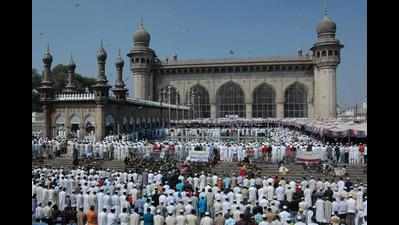- News
- City News
- Hyderabad News
- No Juma-tul-Vida prayers in Hyderabad for first time in 423 years
Trending
This story is from May 22, 2020
No Juma-tul-Vida prayers in Hyderabad for first time in 423 years
For the first time in 423 years the historic precincts of Mecca Masjid, Jama Masjid and Charminar will not witness the congregational Juma-tul-Vida prayers on Friday

No war ever stopped prayers
HYDERABAD: For the first time in 423 years the historic precincts of Mecca Masjid, Jama Masjid and Charminar will not witness the congregational Juma-tul-Vida prayers on Friday due to the coronavirus induced lockdown. The landmark monuments of Hyderabad will not reverberate with the prayers and supplication of the devout on May 22, the last Friday of Ramzan.
Charminar was the first mosque after the city was founded in 1591 CE.Seven years later Jama Masjid, the first congregational mosque was constructed and the Mecca Masjid joined these two in 1694. For the last four centuries, these three iconic structures have always been the centre of the observance of the fasting month of Ramzan, Eid shopping and prayers.
Though there had been three instances of mosques being closed during Ramzan in 429 years of Hyderabad — due to outbreaks of plague, Spanish influenza and cholera — there are no such records to show that the two grand mosques — Mecca Masjid and Jama Masjid — were closed. Even during major calamities including 1908 Musi Deluge and the breakout of World War I in 1914 in which princely Hyderabad had actively supported the British. When the kingdom of Golconda was under siege by the Mughal army led by Aurangzeb in 1687, congregational prayers were offered at the Jama Masjid adjoining Charminar. The Mecca Masjid was still under construction then.
A look at historical data reveals that Juma-tul-Vida coincided with the siege of Golconda that lasted for about eight months. The siege ended on September 22, 1687. That year Ramzan began on July 11 and Juma-tul-Vida fell on August 8. Aurangzeb and his army had camped at what is now Fateh Maidan and drank water from the Hussainsagar lake.
While Juma-tul-Vida occurred on August 21, 1914 after World War I began on July 28. Ramzan occurred two months after the World War II began on September 1, 1939 and Juma-tul-Vida fell on November 10 that year. The Ramzan of 1948 was observed under tension and threat of military action in 1948. Forty-seven days after Juma-tul-Vida the Police Action began leading to the merger of princely Hyderabad with Indian Union. On all these occasions the prayers went on at the three historic monuments — Charminar, Mecca Masjid and Jama Masjid.
Charminar was the first mosque after the city was founded in 1591 CE.Seven years later Jama Masjid, the first congregational mosque was constructed and the Mecca Masjid joined these two in 1694. For the last four centuries, these three iconic structures have always been the centre of the observance of the fasting month of Ramzan, Eid shopping and prayers.
Though there had been three instances of mosques being closed during Ramzan in 429 years of Hyderabad — due to outbreaks of plague, Spanish influenza and cholera — there are no such records to show that the two grand mosques — Mecca Masjid and Jama Masjid — were closed. Even during major calamities including 1908 Musi Deluge and the breakout of World War I in 1914 in which princely Hyderabad had actively supported the British. When the kingdom of Golconda was under siege by the Mughal army led by Aurangzeb in 1687, congregational prayers were offered at the Jama Masjid adjoining Charminar. The Mecca Masjid was still under construction then.
A look at historical data reveals that Juma-tul-Vida coincided with the siege of Golconda that lasted for about eight months. The siege ended on September 22, 1687. That year Ramzan began on July 11 and Juma-tul-Vida fell on August 8. Aurangzeb and his army had camped at what is now Fateh Maidan and drank water from the Hussainsagar lake.
The siege and associated political uncertainty and military tension did not deter people from offering congregational prayers.
While Juma-tul-Vida occurred on August 21, 1914 after World War I began on July 28. Ramzan occurred two months after the World War II began on September 1, 1939 and Juma-tul-Vida fell on November 10 that year. The Ramzan of 1948 was observed under tension and threat of military action in 1948. Forty-seven days after Juma-tul-Vida the Police Action began leading to the merger of princely Hyderabad with Indian Union. On all these occasions the prayers went on at the three historic monuments — Charminar, Mecca Masjid and Jama Masjid.
End of Article
FOLLOW US ON SOCIAL MEDIA











